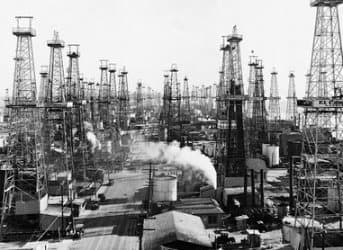Fracking is moving closer and closer to urban areas, but before it actually enters towns and cities the fracking industry should take a look at Long Beach, California, and follow the lessons that have been learnt there.
Back in 1930 the Wilmington oil field was discovered under the streets and harbour of Long Beach, and in 1932 production began to extract the estimated seven billion barrels.
By 1936 some serious subsidence was noted around parts of the city due to the extraction of the oil from beneath the surface. By 1951 and 1952 the city was sinking at around 2 feet a year causing massive damage to roads, buildings, and the harbour.
Related article: How does Fracking Differ from Conventional Oil Recovery
The uncontrolled extraction of the oil and gas lowered the pressure in the hydrocarbon reservoir by a considerable amount. The sands of the reservoir then lacked the structural strength to support the weight above it, leading to a subsidence bowl with a depth of as much as 29 feet covering more than 20 square miles of the city.
The City of Long Beach Department of Oil Properties described the scene: “the ocean inundated wharves, rail lines and pipelines were warped or sheared, while buildings and streets were cracked and displaced.”
Eventually engineers halted the subsidence by injecting water into the reservoir as extraction occurred in order to maintain the pressure.
Once known as the ‘Sinking City’, Long Beach offers a lesson to all intending on extracting hydrocarbons within built up areas, and acts as a strong warning against carrying out such activities without first knowing the exact consequences that they could incur.
By. James Burgess of Oilprice.com



















I'm a petroleum geologist and the cases of subsidence in the U.S. such as happened in the Wilmington can be counted on 1 hand. It is exceedingly rare.
The "fracking industry" no relevance to the solution that was put into place in the Wilmington. It would be like telling the obstetrician she should follow the lessons learned by the gerontologist.
Oil and gas wells are drilled much like houses are built, all of the services are sub-contracted out to firms that specialize in specific services. There are 3 primary companies who do the high pressure pumping known as fracking (Schlumberger, Halliburton, and Baker Hughes). Frac jobs take place after a well has been drilled, last a couple of weeks, and then the well is placed into production and managed by a reservoir engineer (a petroleum engineer who specializes in production and reservoir management) who works for the oil company who had the well drilled. The fracking companies are long gone when production commences.
Re-injecting the salt water that is produced along with the oil was discovered as a method to enhance total recover in the 1950's and has been a useful process to get rid of the unwanted wastewater as well improve oil recovery. The technology that stopped the Wilmington subsidence is obvious to any petroleum engineer in the industry.
So that would solve the problem before it begins.
Got any other scary stories to tell my children before bedtime?
Even a civilian like me knows that modern fracking and early 20th century extraction technology and practices are related to each other exactly as deeply as a horse is related to an airplane.
I'm kind of surprised that this article even got posted.
Of course, everything is political in today's world.
You engineers should know this! I'd expect to hear less 'Sinking wells can't happen nowadays you dummy!' and maybe more 'We as engineers are aware of past mistakes in this and other fields, and while you might dispute WHAT we're doing, we do it with a proactive mind to preventing and quickly fixing dangerous problems'.
So the author didn't explicitly state it, I will: when trying anything new, shit can go bad. We made it to space, but shuttles exploded and astronauts died. We have flying vehicles, but we had to learn from the mistake of zeppelins. We have nuclear power plants, but Three Mile Island and Chernobyl were very expensive lessons.
So I do hear arrogance in these comments, and would encourage less of it.
As for the article itself, we all kind of know companies give too much authority to managers in technical matters, and they override the informed decisions of engineers to make a profit all the time. So, I doubt fracking would listen to the lesson of the sinking city.